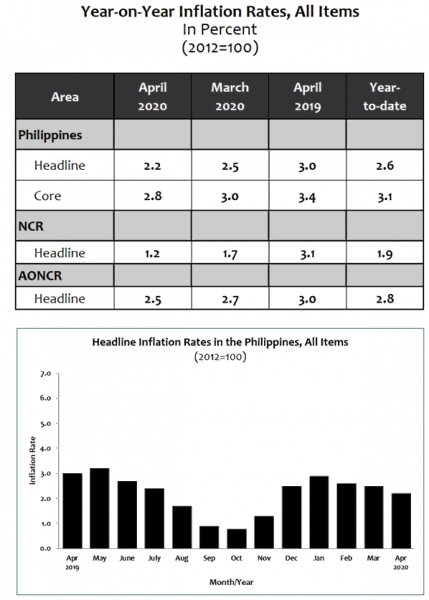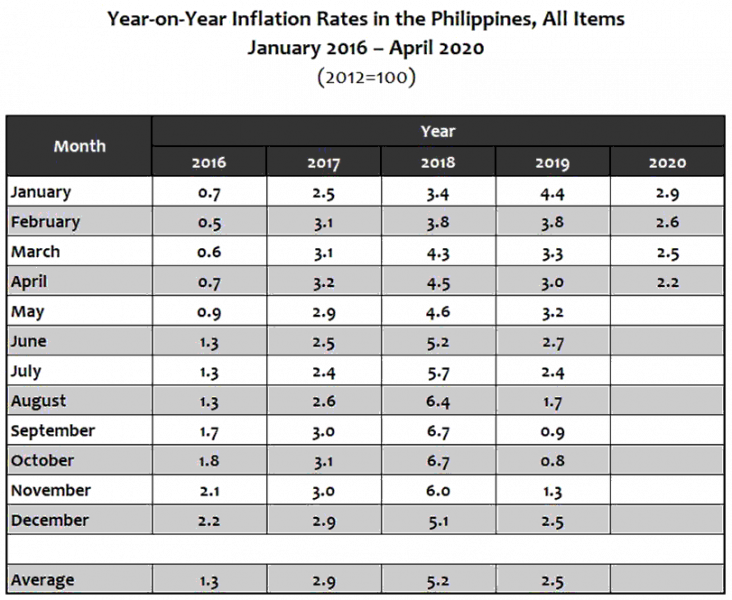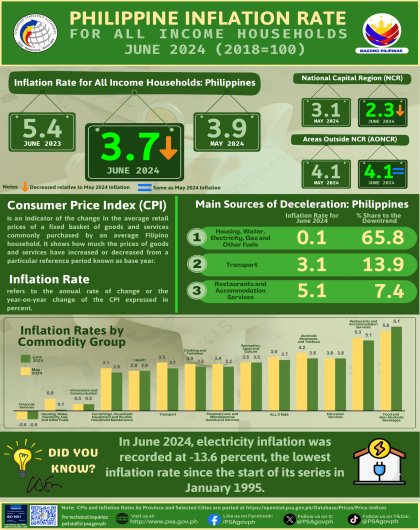Summary Inflation Report Consumer Price Index (2018=100): June 2024
Philippines
The headline inflation at the country level settled at 2.2 percent in April 2020 which was slower than the 2.5 percent annual increase in March 2020. This brings the year-to-date inflation for this year to 2.6 percent. In April 2019, inflation was higher at 3.0 percent.
Contributing to the downtrend in the headline inflation in April 2020 was the further decrease in the annual rate of transport index at 6.1 percent. This was the lowest inflation recorded in this group’s index since October 2015. In addition, slower annual mark-ups were seen in the indices of the following commodity groups:
- Alcoholic beverages and tobacco, 17.9 percent;
- Clothing and footwear, 2.6 percent;
- Housing, water, electricity, gas, and other fuels, 0.3 percent;
- Health, 2.8 percent;
- Communication, 0.3 percent; and
- Restaurant and miscellaneous goods and services, 2.4 percent. (Tables 3 and 4)
Meanwhile, the index of the heavily-weighted food and non-alcoholic beverages posted a higher annual increment of 3.4 percent during the month. The indices of the rest of the commodity groups such as furnishing, household equipment and routine maintenance of the house, recreation and culture, and education retained their previous month’s annual growth rates. (Tables 3 and 4)
Core inflation, likewise, continued to move at a slower rate in April 2020 at 2.8 percent, from 3.0 percent in March 2020. In April 2019, core inflation stood at 3.4 percent. (Table 9)
The annual rate of the food index at the country level picked up further to 3.4 percent in April 2020, from 2.6 percent in the previous month. (Table 7)
The indices of fruits and vegetables registered double-digit annual growth rates of 12.1 percent and 10.3 percent, respectively from their respective previous month’s annual rates of 9.9 percent and 8.1 percent. Moreover, higher annual increases were recorded in the indices of milk, cheese and eggs at 3.6 percent; oils and fats,1.6 percent; and food products, not elsewhere classified, 8.1 percent.
The annual growth rates, however, slowed down in the indices of meat at 2.5 percent and fish at 10.0 percent, while the index of other cereals, flour, cereal preparation, bread, pasta and other bakery products retained its previous month’s annual rate of 2.6 percent. Annual growth rates In the indices of other food groups such as rice (-3.8%); corn (-0.5%); and sugar, jam, honey, chocolate and confectionery (-0.8%) continued to move downward during the month. (Table 5)

National Capital Region (NCR)
Similarly, inflation in NCR eased further to 1.2 percent in April 2020, from 1.7 percent in the previous month. The year-on-year inflation in the area in April 2019 was higher at 3.1 percent.
The slowdown in the inflation in NCR was due to the continued declines in the annual rates posted in the indices of housing, water, electricity, gas and other fuels at 1.7 percent; and transport at 6.5 percent. Contributing also to the downtrend in the inflation in the area was the slower annual hikes in the indices of recreation and culture at 0.7 percent and in restaurant and miscellaneous good and services at 1.9 percent.
On the contrary, the index of furnishing, household equipment and routine maintenance of the house exhibited higher annual increment of 5.8 percent during the month. The indices of other commodity groups retained their previous month’s annual growh rates. (Tables 3 and 4)
Areas Outside NCR (AONCR)
Annual inflation in AONCR also decelerated further to 2.5 percent in April 2020, from 2.7 percent in March 2020. In April 2019, inflation in AONCR was posted at 3.0 percent.
Further drop in the annual rate of transport index at 6.0 percent during the month primarily pushed down the inflation in AONCR. Moreover, slowdowns in the annual hikes were noted in the indices of the following commodity groups:
• Clothing and footwear, 2.9 percent;
• Housing, water, electricity, gas, and other fuels, 1.1 percent;
• Furnishing, household equipment and routine maintenance of the house, 3.7 percent;
• Communication, 0.3 percent; and
• Restaurant and miscellaneous goods and services, 2.6 percent.
On the other hand, the annual rate in the index of food and non-alcoholic beverages moved up further to 3.4 percent during the month. The indices of the rest of the commodity groups retained their annual rates in March 2020. (Tables 3 and 4)
Nine regions exhibited lower inflation during the month, with Region X (Northern Mindanao) maintaining the lowest inflation at 1.4 percent. Meanwhile, the highest inflation was still observed in Region XII (SOCCSKSARGEN) with an annual increment of 3.6 percent. (Table 4)
Notes:
- CPIs and inflation rates by province and selected cities are posted at the PSA website (http://openstat.psa.gov.ph/)
- The PSA was able to collect prices from the sample markets/outlets even during the Enhanced Community Quarantine (ECQ) in NCR and other regions/provinces. Normally, face-to-face interview or visit to sample markets/outlets is done to collect prices. However, when face-to face interview was not possible in some areas during the ECQ, alternative approaches such as phone call/text to sellers of the sample outlets; email to sample outlets, and other alternative approaches/strategies were done to collect prices.
(Sgd) CLAIRE DENNIS S. MAPA, Ph.D.
Undersecretary
National Statistician and Civil Registrar General
See more at the CPI and Inflation Rate page.


